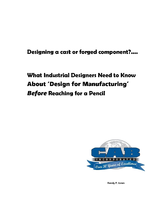Software delivers mechanical design automation through KBE.
Press Release Summary:
QuickDesign merges object-oriented programming and Knowledge Based Engineering with CAD technology. It presents simple 2D interface to user and is powered by SolidWorks® solid modeling software. Resource Manager processes design attributes submitted by end user in accordance with design rules database. Outputs are 2D drawings, 3D parametric models, customer quote, and bill of material. QuickDesign can validate designs through automatic execution of standard CAE analyses.
Original Press Release:
Fisher/Unitech Announces QuickDesign Software Solution for Knowledge-Based Engineering
Engineering Technologies & Services Provider Enables Clients with Custom Solution for Automating Product Development
Troy, MI (July 15, 2002) - FISHER/UNITECH, a leading engineering technologies firm, today announces its QuickDesign software solution, a customized system that delivers mechanical design automation through Knowledge Based Engineering. QuickDesign presents a simple 2D interface to the user and is powered by SolidWorks® solid modeling software. This system has been proven to shorten product development cycles by significant margins, in many cases up to 90%. Among several benefits companies will realize by implementing QuickDesign is the reuse of existing product designs in development of new products. In essence, an overall improvement in productivity, product quality and increased revenue is achieved.
Recent studies conducted separately by the National Academy of Engineering (NAE) and the Office for Study of Automotive Transportation (OSAT) have shown that few organizations have been able to identify significant gains in product development in the last 20 years. Although many companies have seen improvements with the implementation of 3D solid modeling techniques, product design processes are still largely unstructured and too few experts are readily available for product design and attribute prediction.1
By the end of this decade Knowledge Based Engineering (KBE) will be to companies what computer-aided design, engineering and manufacturing were in the 1990s. Combined with solid modeling and analytical prototyping, KBE will be the process that enables engineers to exploit the full potential of Computer Aided Engineering.2
QuickDesign is architected to deliver scalable KBE solutions so that it may be applied for a varied range of applications. Very complex design applications, such as body structures, or more simple, parametric dependent applications can both be addressed economically with the software. The system automates repeatable design tasks, and is ideal for companies whose products are variants of a general design theme or model.
The first step in customizing QuickDesign for a client is to capture the company's design rules and engineering expertise, which will serve as the corporate knowledge base or design rules database portion of the software. The design rules can be applied in any combination of: if-then-else, regression, look up tables, database or web links. The end result is a simple-to-use 2D interface that provides endless product combinations that don't have to be designed from scratch. The end user has the ability to add or delete rules and component parts from the database in accordance with corporate engineering changes.
For the end user, QuickDesign requires no programming. Users do not need to learn the variety of engineering applications leveraged within the program. A typical end user would simply input product specifications into a familiar dialog box, using either a Windows or web-browser based client. From this point, QuickDesign's Resource Manager does the work. The Resource Manager is the custom pre-programmed application at the core of QuickDesign; it processes the design attributes submitted by the end user in accordance with the design rules database. Outputs are 2D drawings, 3D parametric models, a customer quote and bill of material. QuickDesign can validate designs through the automatic execution of standard CAE analyses.
QuickDesign can be either stand-alone or client-server based, depending upon the complexity of the design rules database and the number of desired users. Rules are managed with either Oracle or Excel. QuickDesign is the successful merger of object-oriented programming and KBE with leading CAD technology. The solution is an ideal fit for manufacturers of office furniture, windows and doors, truck and trailer bodies, conveyors and fabricators. The benefits are shortened delivery times, fewer design resources, and increased revenues beyond what current 3D modeling and analysis can provide.
"QuickDesign offers our customers the most strategic and financially beneficial application available today that could revolutionize their entire design process. We are very excited about the opportunities that exist for our clients who decide to implement a QuickDesign system," said Charles Hess, President, FISHER/UNITECH.
Company Background
Founded in 1993, FISHER/UNITECH (www.funtech.com) is headquartered in Troy, Michigan, and has branch offices located strategically throughout the Midwest. The Company is a leading reseller of CAD/CAM/CAE/CAID software, and offers a broad range of comprehensive engineering services including conceptual design, styling, engineering and rapid prototyping. FISHER/IJNITECH is a Ford Motor Company Certified Data Service Provider. The Company also offers complete system administrative and networking support services.
1 Excerpt provided by Gordon Willis of VulcanWorks LLC.
2 Howard C Crabb - The Virtual Engineer, 21st Century Project Development - Society of Manufacturing Engineers 1998 - ISBN: 0-87263-491-4.




